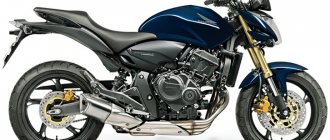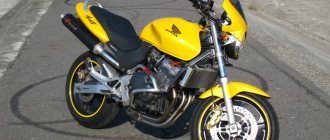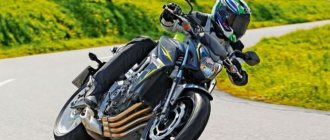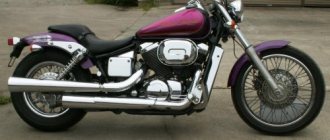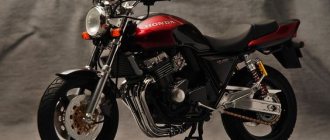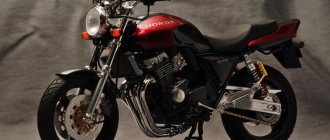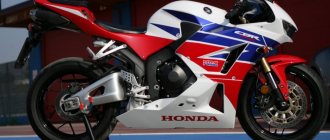Bike features
Here are the main features of the model:
- good dynamic characteristics;
- this bike is designed for one person rather than two;
- 25 Nm and 40 hp. at maximum.
The motorcycle is well suited for the city. The Honda CB 250 F Hornet can also please experienced motorcyclists, because this model is maneuverable and powerful beyond its size. Perhaps this is one of the best motorcycles among the urban classics, which, moreover, can be bought for little money.
The Honda Hornet CB 250 F is a motorcycle designed for beginners that can pleasantly and carefully introduce a novice biker to the world of two-wheeled vehicles. However, the baby is surprisingly “muscular” and will be able to pleasantly surprise even an experienced motorcyclist. By the way, the Hornet 250 is also somewhat popular among experienced bikers, since it is inexpensive, consumes little gasoline, and has more than enough capabilities for everyday driving around the city. Except that you have to change gears more often than on some Honda CB 400 or Honda CB 750, but can this be considered a disadvantage?
The capabilities of the small-capacity Honda Hornet 250 are truly pleasantly surprising, as is this entire motorcycle as a whole. A classic road builder, slightly modernized in appearance, successfully combines good technical characteristics, simplicity and timeless style. Perhaps, in its class it can even be called one of the best, and this would not be an exaggeration. Moderately compact, lightweight, and powerful (by the standards of the class, of course), the Hornet 250 is a perfectly balanced city bike, which in terms of ease of everyday riding is in no way inferior to everyone’s favorite Honda CB 400.
A full-fledged 4-cylinder liquid-cooled engine is inserted into the steel frame, working with carburetors and a modern 6-speed transmission. The Honda Hornet 250 engine loves high speeds, and for dynamic driving it needs to be “twisted” - this is the price to pay for good parameters taken from a small-capacity engine. The Hornet 250 produces a torque of 24 nM at around 11,000 rpm, and maximum power of 40 forces at around 14,000 rpm. For an inexpensive urban classic with a quarter engine, these are excellent figures. Despite the rather modest size of the Hornet 250, its ergonomics are excellent. A comfortable and relaxed driving position is guaranteed for a motorcyclist of almost any height, except perhaps very strong ones. The instruments, hidden in chrome “glasses,” are perfectly legible, and all controls are located in the usual places. The dry weight of the Hornet 250 is only about one hundred and fifty kilograms.
The motorcycle's suspension design is classic, with a telescopic fork at the front and one monoshock absorber at the rear. It can confidently be called comfortable, however, if there is a passenger, the motorcycle noticeably “sags”. After all, the Honda Hornet 250 is designed primarily for driving alone, although no one forbids taking a passenger to their destination if necessary, of course. By the way, you will rarely have to refuel along the way - the average consumption of the Hornet 250 is about 4 liters per hundred, and the volume of the gas tank is as much as 16 liters. The brakes deserve attention, and attention in every sense. There is one brake disc on both the front and rear wheels of the Hornet 250, and the motorcycle brakes very effectively. Moreover, you have to be very careful with the front brake - it is so grippy that you can overdo it. But there is no doubt that in an emergency, the Hornet 250's capabilities are enough to stop quickly.
The 250cc Hornet is definitely one of the best in its class. Small, light, great to handle, it accelerates in a way you wouldn't expect from it. True, after 120 km/h the engine runs out of steam, and to maintain dynamics in city driving you have to change gears frequently, but this certainly doesn’t make the Honda Hornet 250 any worse.
Engine
The CB 250 F is equipped with an in-line, four-stroke and four-cylinder engine. This unit has an effective volume of 249 cm³, and it is cooled by liquid. Its peak torque of 25 Nm is achieved at 11,000 rpm, while power peaks at 40 hp. will be at 13000 rpm. Such high speeds are a consequence of the small engine volume. The maximum speed of the bike is 180 km/h, while it accelerates to 100 km/h in 5.3 seconds.
Review of the Honda Hornet 250 (CB 250 F) motorcycle
I really liked the motik. The service is not expensive, but in the first place there is a lot of incomprehensibility due to the lack of information on it (the same air filter is installed from the older Hornet (600ki), but there is no such thing in the explanations for the 250k).
The engine is a chainsaw buzzer))) but it seems like the Japanese cult (deformed from Siberia) drive of the camshafts by gears (no need to play tricks with tensioners and dampers) and in general such a cheerful jerk.)) You can even say that it “feels”.
The ride is as simple as a samurai’s sword. There’s not even a progression, which doesn’t stop you from having fun on the track (provided that the carcass weighs less than 90 kg. Otherwise, it’s no longer possible to shift with the power of thought, and there aren’t enough brakes).
Long-distance travel is for masochists (my personal record of self-torture Moscow-Samara in one day). Still, this is a naked bike with a complete lack of any wind protection and with a non-touring seating position.
A very interesting urban matsacycle. A good alternative to the “old liter” for small ponto cutters with no experience. It will forgive more mistakes and give you experience.
So, a small motorcycle! First of all, what is striking is the non-childish size of the tires (the same as, for example, on the 900 Fireblade), namely: 120 in front and 180 in the rear. More than enough for a revving 40-horsepower skate with a volume of 4x62 cc. When viewed from above, we see a kind of thin, elegant motorcycle. The engine is quite compact, and no wonder - after all, the cylinder diameter is only 48.5 mm. The dashboard is traditional, reminiscent of a roadster panel.
Motor. Choke on the steering wheel. Starting a cold or hot engine with a little gas assistance is no problem. Sufficient torque for a decent start at moderate speeds. You don’t even notice the 8000/min mark, because there is no vibration. It does not exist even when the engine is fully cranked. No mechanical noise. Smooth traction throughout the entire operating range. The high-pitched sound is like the voice of an opera diva hitting the highest note - just super. Checking the oil level using a dipstick.
Clutch and gearbox. Light and soft clutch, cable drive. Six-speed gearbox. Switching is easy and precise.
Chassis. Good, stable roll with a maximum speed of 201 km/h. The steering is easy and tends to the outside when cornering. In case of poor coverage, there are clear and predictable reactions to turning the steering wheel. The brakes are good. The pendants also meet the requirements.
Comfort. Good communication between motorcycle and driver. Even people taller than 180 do not feel uncomfortable. The controls do not require adjustment, everything is at hand. The energy intensity of the suspension is high. Ideally suited for a driver weighing 90 kg. The passenger seat is a bit high, but provides an acceptable level of comfort.
Brakes. Front and rear disc. Excellent deceleration. Up front are 4-piston. The manual control is quickly repositioned. They grip and dose well, even on damp surfaces.
Consumption. Despite the high level of revolutions, it produces 6 liters per 100. Possible maximum range is 250 km.
Equipment. Expensive, but excellent road holding motorcycle tires.
Total: version 250 for daily trips. Stylish, nimble, fast.
The mot is good, playful, it seemed to me not enough after 2 months. but there is one minus that covers everything: spare parts... not much. good if made to order. and you won’t find anything at all. if you still find something on the engine. But if you put it on its side, I can’t imagine where you’ll look for all these spare parts. I'll say this. I couldn’t find an air filter for it anywhere, neither in Europe nor in America. So I sold it with the old air vent. the output is of course 400k is common. I’m now on Siber 600 and I’ll say this, there are spare parts for sports in every stall. I had a Hornet 600, which seemed to be a popular moto, but I still had problems with the instrumentation and other things when I used it. You need to have spare parts, otherwise it falls, and the bike sits for 3-4 months while you look for spare parts.
Dimensions and weight
The length of the CB 250 F is 2045 mm, while its height is 1055 mm and its width is 740 mm. The wheelbase here is 1415 mm, and the seat height is 760 mm. The weight of the motorcycle without fuel is 149 kg, and with it – 166 kg. The fuel tank volume is as much as 16 liters, which is a lot with an average gasoline consumption per 100 km of approximately 4 liters.
Ergonomics and ride quality
The compact dimensions of the Hornet 250 do not in any way affect its ergonomics: a convenient and comfortable fit is provided even for tall motorcyclists. The motorcycle’s instruments are highly informative and hidden in chrome “glasses”; the main controls are located at hand. The curb weight stated in the technical specifications of the Honda Hornert 250 is 150 kilograms.
The suspension design is classic, represented by a rear monoshock absorber and a front telescopic fork. When there is a passenger, the motorcycle sags noticeably, but this does not affect the suspension parameters - it perfectly conceals road unevenness. The Hornet 250 is not designed to carry a passenger, but this does not prevent it from carrying a second person over considerable distances.
The 16-liter fuel tank provides good autonomy for the motorcycle and allows you to cover long distances without refueling. The braking system is made up of disc mechanisms and is highly effective, but the front disc is too grippy, so you need to control it when stopping. The braking system allows you to quickly stop the motorcycle even at high speed.
Chassis and brakes
The frame of this bike is made of steel. It has a stylish, modern look, but at the same time there is nothing unique about it. The wheels of this machine are alloy, like most road bikes, and the elegant steering wheel has classic dimensions.
The rear suspension is a pendulum version with a shock absorber, the travel of which is 128 mm. The front suspension with 125 mm of travel is represented by a 36 mm telescopic fork. The rear brake is a 220 mm disc along with a single-piston caliper. A 296 mm disc along with a four-piston caliper brakes at the front.
Honda CB600F Hornet
First generation (1998–1999 type PC 34)
A successful trial launch of the Honda CB 250 Hornet on the domestic market served as an impetus for the development of a similar motorcycle for the European market. Thus was born the CB600F Hornet, which immediately achieved popularity similar to that of its younger brother in Japan.
The naked Honda CB 600 F Hornet has at its disposal a reliable engine from the sports tourer CBR600 F, which is located in the backbone frame and is part of its power structure (the engine is not located inside a closed frame, but is itself part of the frame). Compared to the donor engine, the horsepower of the Hornet’s power plant was slightly reduced (due to changes in valve timing and intake manifolds) in order to level out the hysteria inherent in sports motorcycles and to obtain an increase in torque at the “bottoms”. This downgrade has improved the behavior of the motorcycle in the city; the lack of wind protection does not make you feel a lack of power. The only possible bottleneck of the engine is the timing chain tensioning mechanism (inherited from the CBR family, can only be treated by regularly replacing the unit). The chassis is budget-friendly (non-adjustable telescopic fork at the front and a monoshock absorber with preload adjustment at the rear), but at the same time meets the capabilities of the motorcycle. Braking mechanisms are similar to those installed on the CBR 600 F 3 (two two-piston calipers at the front and one single-piston at the rear).
Second generation (2000–2002 type PC 36)
Two years after the start of production, the motorcycle underwent a number of significant changes - the size of the front wheel increased (it was 130/70ZR16, it became 120/70ZR17), resulting in greater stability on the road, the settings of the fuel system changed and the appearance changed significantly. The motorcycle has become leaner, the smooth lines of the plastic cladding have been replaced by significantly better drawn muscles with sharp stampings. Visually, the second generation can be distinguished from the first by the following features: sharper edges on all plastic parts, black brake calipers (the first generation had gold ones), red spark plug caps and a monoshock spring, engine covers became flatter, the exhaust pipe casing got rid of perforations and received two separate sections, the plastic trim under the seat was divided into two parts, the taillight no longer sticks out beyond the plastic tail, the headlight has a new mounting bracket.
In the same year, a slightly dressed-up version of the CB600FS was released. The differences from the standard naked are concentrated in the front part of the motorcycle - the place of the round headlight was taken by an elongated block headlight with a small fairing, on the edges of which oval rear-view mirrors were installed; the place of the classic tidy was taken by a unit from the VTR1000 Firestorm.
Third generation (2003–2005 type PC 36)
In 2003, the Hornet was modernized again. The changes mainly affected the appearance. The headlight acquired a convex glass, the rear light slightly changed its shape and became a little smaller in size, the usable volume of the seat space increased, the side plastic again underwent changes (this is especially evident from the solid plastic panel on the side), the seat became even more profiled, the mirrors changed shape from round to square, the exhaust pipe now has a tapered tail and shoots upward at an even sharper angle. The only technical changes are an increased gas tank (17 liters versus 16 on previous generations) and a weight reduction of 2 kg. Unfortunately, production of the CB600SF half-fairing version has ceased at this point. In 2003, the entire Hornet line was universally equipped with the Hiss security system on Honda motorcycles.
Fourth generation (2006 type PC 42)
The 2007 version is transitional, the last push before the release of a fundamentally new motorcycle. It is distinguished from the previous generation Hornet by an inverted front fork with a diameter of 41 mm, an updated front fender with slots on the sides, a small round headlight, a refreshed dashboard with a small fairing, gold-colored brake calipers and minor cosmetic changes.
Interesting facts: the engine installed on all Hornets can safely be called indestructible; problems can arise only with extremely irresponsible operation. The backbone frame, on the contrary, is not particularly reliable and practical; in the event of an accident, part of the frame in the area of the gas tank often “plays”, as a result of which the alignment of the wheels may be lost and the wheelbase may decrease. You should approach the choice of protective arches with caution, and avoid installing sliders at all. Frequently encountered problems - in traffic jams the engine is prone to overheating and the battery drains, the exhaust system fries the driver to the point of getting burns, and in case of falls, in addition to the frame, the gas tank, muffler and dashboard are damaged.
Fifth generation (2007–2010 type PC 42)
A revolutionary new motorcycle both in concept and appearance. The classic design was replaced by a futuristic one, reminiscent of a cyber hornet; the model moved from neoclassical to the streetfighter class. Unfortunately, the assertive and hooligan character of the Hornet has been lost, along with its ergonomics, aimed at the average well-fed adult. Now in the model line this motorcycle occupies a niche of motorcycles for beginner oversized pilots and girls. In order not to scare off picky modern buyers, the motorcycle was equipped according to the most modern trends. The engine was taken from a 2007 CBR600RR (derated to 102 hp), packaged in a backbone frame with aluminum subframes and mounted on an inverted fork and a new swingarm design with a monoshock absorber. Already obsolete two-piston calipers gave way to three-piston ones as part of the CBS combined braking system, and ABS finally appeared. The fuel tank has increased to 19 liters. Design research was made without regard to the past, instead of a round headlight there is an aerodynamic insect nose, the instrument panel is no longer made in the form of two wells, but is an entire flight control center. The layout of the units is aimed at mass centralization; the entire exhaust system is concentrated under the belly, with only a small exhaust pipe body sticking out.
The apparent perfection also has a downside - the motorcycle has become even more sensitive to falls. Having attached the updated model, you will most likely head straight to the dealer to order an extensive list of spare parts, the prices for which are very high.
Sixth generation (2011 – present)
The sixth generation is directly derived from the fifth. All technical components remained the same, the appearance has changed slightly. The first thing that catches your eye is the new headlight, divided into two sections, and the noticeably thinner and raised tail. The instrument panel has become even more equipped with nanotechnology and is now a single liquid crystal screen with all the necessary readings.
